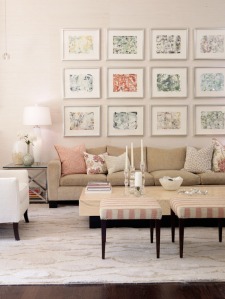Now that you have your new furniture, the next step is arranging it. Where you place your furniture in a room will ultimately set the tone for how you live in it. Here are seven must-know tips for arranging your living room, whether you’re relaxing with family, entertaining friends or watching TV.
The first step in arranging any room is determining just how much space you have to work with. You can use a tape measure to get dimensions or simply measure your foot and walk heel to toe across the room.
To add visual interest to a room you should incorporate a variety of furniture with different characteristics. For example, use an extra-large sectional with small armchairs and side tables to create an energetic vibe in your living room with various volumes.
When furnishings are out of scale you’ll notice that it just doesn’t feel comfortable or right. That being said, make sure you use scaled pieces to create balance. Note that similarly scaled pieces create a more serene atmosphere when used together.
There are two forms of balance: symmetrical and asymmetrical. Decide which you’d like in your living room. While symmetry is very restful, asymmetry adds visual motion and excitement. Asymmetry refers to imbalance, for example to candles of slightly different sizes next to each other.
When designing your home, try thinking like an artist. Look at your space like a painter looks at a piece of art. One trick painters use is ‘triangulation’. In interior design, this can be utilized by placing two end tables on either side of a sofa with a painting above it.
Another trick painters use is the creation of depth in artwork. Paintings often have foreground, midground, background and vanishing point. Placing a chair at an angle can be the foreground. A cocktail table will provide a midground and a sofa with the wall behind it will serve as the background. A window or painting placed above the sofa will give you a vanishing point.
All furniture arrangements should have a certain gestalt, or ‘totality’ or ‘form’. For instance a long, narrow living space can be split in two by creating different zones of function. Create one half for the sofa and the function of conversing, and the other half for a dining set and function of dining. Dividing rectangular rooms into squares according to their function helps to make us feel more comfortable and less formal, which is exactly what we want for our living room!




No comments:
Post a Comment